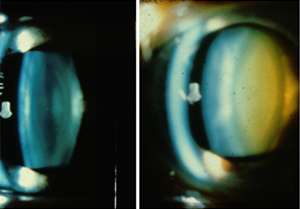Software to grade cataracts could lead to improved management

Cataracts are the main cause of visual impairment worldwide and account for more than 50 per cent of blindness in developing countries. Diagnosis of the condition generally involves a labor-intensive method of ophthalmic examination and grading by comparing the individual's lens against a set of standard reference photographs (see image).
Now, Yanwu Xu and co-workers from the A*STAR Institute for Infocomm Research, together with researchers in Singapore and China, have developed a system to grade the severity of cataracts automatically using slit-lamp photographs. The technique offers potential for improved clinical management of cataracts and may be extended to other eye conditions in the future.
Cataracts are categorized as nuclear, cortical or posterior, according to their location and appearance. The researchers studied nuclear cataracts, the most common type of cataract, which involve clouding, or opacification, of the central part of the lens. Xu and co-workers analyzed a database of 5378 images taken using slit-lamp illumination, the standard method for examining and photographing cataracts.
From this analysis, the research team developed a computer-based system in which each image of a lens is divided into three sections—nucleus, anterior cortex and posterior cortex—and visual features are extracted from a grid of overlapping patches for analysis. The software uses a statistical process, known as group sparsity regression, to determine each cataract's grade on a standard scoring system. The distinguishing aspect of the group sparsity regression step is that it selects just a few groups of features of intensity and texture in each image, which reduces the influence of random noise and increases the speed of computation.
While not the first attempt to grade cataracts automatically, the researchers found that their system outperforms existing methods by more closely matching the results of manual grading by experienced clinicians.
"Manual assessments can be subjective, time-consuming and costly," says Xu. "Our automated system offers the prospect of greater objectivity and efficiency in diagnosing and monitoring this major condition in huge numbers of people. In addition to the initial diagnosis it could also help doctors to monitor the progression and treatment of cataracts."
The researchers now hope to refine their software and to explore the possibility of applying it to other eye conditions such as pathological myopia, glaucoma and age-related macular degeneration. Their ultimate aim is to develop a more comprehensive commercialized system.
"The computation is not complex," explains Xu. "It could form an ocular screening platform based on cloud computing technology that could also provide a remote service."
More information: Xu, Y., Gao, X., Lin, S., Wong, D. W. K., Liu, J. et al. "Automatic grading of nuclear cataracts from slit-lamp lens images using group sparsity regression." Medical Image Computing and Computer-Assisted Intervention – MICCAI 2013, Lecture Notes in Computer Science 8150, 468–475 (2013). dx.doi.org/10.1007/978-3-642-40763-5_58

















